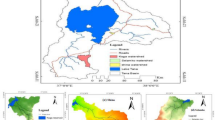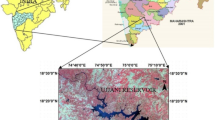Abstract
Water reservoirs in most parts of the world face the problem of sedimentation. Environmental impacts and land-use changes/landslide have enormous potential to generate more sediment load in water reservoirs. Hence, the capacity of water reservoirs in Pakistan has been constantly reducing due to sedimentation. In this study, we have computed the environmental impacts on sedimentation load in Tarbela and Mangla water reservoirs using multi-satellite and ground-based data. The total drainage area of watershed is calculated using Shuttle Radar Topographic Mission data. Satellite data from NOAA-AVHRR are used to monitor urban development and changes in vegetation area, while MODIS data are used to estimate the snow area in the watershed region. Normalized Difference Vegetation Index is used to estimate the temporal changes in vegetation cover, whilst principle component analysis is applied to monitor urban changes in watershed region. Similarly, snow cover area in the study region is estimated using Normalized Difference Snow Index algorithm. Rainfall data obtained from Pakistan Meteorological Department are used to evaluate the relationship between sedimentation deposited in water reservoirs and annual rainfall amount. Results of the current study reveal that increase in urban development and high amount of precipitation has direct relationship with the load of sedimentation, while amount of vegetation has inverse relationship with the load of sedimentation in water reservoirs of the country.






Similar content being viewed by others
References
Ahmed SI (2015) Real estate trumps water in Pakistan’s capital. In: Understanding Asia’s water crisis. thethirdpole.net. Available via DIALOG. https://www.thethirdpole.net/2015/10/11/real-estate-trumps-water-in-pakistans-capital. Accessed 20 Feb 2016
Apitz SE, Power B (2002) From risk assessment to sediment management: an international perspective. J Soils Sediments 2:61–66
Apitz SE, White S (2003) A conceptual framework for river-basin-scale sediment management. J Soils Sediments 3:132–138
Ault TW, Czajkowski KP, Benko T, Coss J, Struble J, Spongberg A, Templin M, Gross C (2006) Validation of the MODIS snow product and cloud mask using student and NWS cooperative station observations in the Lower Great Lakes Region. Remote Sens Environ 105:341–353. https://doi.org/10.1016/j.rse.2006.07.004
Bajgiran PR, Darvishsefat AA, Khalili A, Makhdoum MF (2008) Using AVHRR-based vegetation indices for drought monitoring in the Northwest of Iran. J Arid Environ 72:1086–1096
Belaud G, Khan AK, Nabi G (1998) Sediment behavior of Sangro distributary, Mirpurkhas sub-division, Sindh. Pakistan national program international irrigation management institute and French research center for agricultural and environmental engineering in collaboration with international sedimentation research institute Pakistan (Report no. R-53). Retrieved from international water management institute. http://www.iwmi.cgiar.org/publications/other-publication-types/pakistan-reports/
Butt MJ (2012) Characteristics of snow cover in the Hindukush, Karakoram and Himalaya (HKH) Region Using Landsat Satellite Data. Hydrol Process 26:3689–3698. https://doi.org/10.1002/hyp.8375
Butt MJ (2013) Exploitation of landsat data for snow zonation mapping in Hindukush, Karakoram and Himalaya (HKH) Region of Pakistan. Hydrol Sci J 58(5):1088–1096. https://doi.org/10.1080/02626667.2013.799774
Butt MJ, Waqas A, Mahmood R (2010) The combined effect of vegetation and soil erosion in the water resource management. Water Resour Manag 24(13):3701–3714. https://doi.org/10.1007/s11269-010-9627-7
Butt MJ, Mahmood R, Waqas A (2011) Sediments deposition due to soil erosion in the watershed region of Mangla Dam. Environ Monit Assess 181(1–4):419–429. https://doi.org/10.1007/s10661-010-1838-0
Campbell TB (2002) Introduction to Remote Sensing, 3rd edition, 2002, Taylor and Francis
Chander G, Markham BL, Helder DL (2009) Summary of current radiometric calibration coefficients for landsat MSS, TM, ETM + , and EO-1 ALI Sensors. Remote Sens Environ 113:893–903
de Asis AM, Kenji O (2007) Estimation of vegetation parameter for modeling soil erosion using linear Spectral Mixture Analysis of Landsat ETM data. ISPRS J Photogramm Remote Sens 62:309–324
Dobos E, Daroussin J (2005) The derivation of the potential drainage density index (PDD). In: Dobos et al. (eds) An SRTM-based procedure to delineate SOTER Terrain Units on 1:1 and 1:5 million scales. EUR 21571 EN. Office of Official Publications of the European Communities, Luxemburg
Dobos E, Daroussin J, Montanarella L (2007) A quantitative procedure for building physiographic units for the European SOTER database. In: Peckham RJ, Jordan G (eds) Digital terrain modelling. Lecture notes in geo-information and cartography. Springer, Berlin, Heidelberg
Domenikiotis C, Dalezios NR, Loukas A, Karteris M (2002) Agreement assessment of NOAA/AVHRR NDVI with Landsat TM NDVI for mapping burned forested areas. Int J Remote Sens 23:4235–4246
Farr TG, Kobrick M (2000) Shuttle radar topography mission produces a wealth of data. Am Geophys Union Eos 81:583–585
Gao Y, Xie H, Lu N, Yao T, Liang T (2010) Toward advanced daily cloud-free snow cover and snow water equivalent products from Terra-Aqua MODIS and Aqua AMSR-E measurements. J Hydrol 385(1–4):23–35
Hall DK, Martinec J (1985) Remote sensing of ice and snow. Chapman and Hall, London, p 189
Hall DK, Riggs GA, Foster JL, Kumar SV (2010) Development and evaluation of a cloud-gap-filled MODIS daily snow-cover product. Remote Sens Environ 114(3):496–503
Hanif M, Subhan F, Megahan WF (1990) Watershed restoration reduces runoff and sedimentation from comparative watersheds in Pakistan’s subtropical scrub zone. Research needs and applications to reduce erosion and sedimentation in tropical steeplands proceedings of the Fiji symposium, June, IAHSAISH Publ. No. 192
Hasan A, Raza M (2009) Migration and small towns in Pakistan. Working paper series on rural-urban interactions and livelihood strategies. International Institute for Environment and Development (IIED) Working Paper 15. http://pubs.iied.org/pdfs/10570IIED.pdf
Huete A, Didan K, Miura T, Rodriguez EP, Gao X, Ferreira LG (2002) Overview of the radiometric and biophysical performance of the MODIS vegetation indices. Remote Sens Environ 83:197–213
Jarvis A, Rubiano J, Nelson A, Farrow A, Mulligan M (2004) Practical use of SRTM data in the tropics-comparisons with digital elevation models generated from cartographic data. International Center for Tropical Agriculture, working document no. 198, Apartado Aereo 6713 Cali, Colombia. http://ciat-library.ciat.cgiar.org/articulos_ciat/Jarvis4.pdf
Lillesand TM, Kiefer RW (2002) Remote sensing and image interpretation, 4th edn. Wiley, New York
López-Burgos V, Gupta HV, Clark M (2013) Reducing cloud obscuration of MODIS snow cover area products by combining spatio-temporal techniques with a probability of snow approach. Hydrol Earth Syst Sci 17(5):1809–1823
Nalbantis I, Tsakiris G (2009) Assessment of hydrological drought revisited. Water Resour Manag 23:881–897
Nasir A, Uchida K, Ashraf M (2006) Estimation of soil erosion by using RUSLE and GIS for small Mountainous Watershed in Pakistan. Pak J Water Resour 10(1):11–21
Ouyang W, Hao FH, Lin C (2010) Vegetation response to 30 years hydropower cascade exploitation in upper stream of Yellow River. Commun Nonlinear Sci Numer Simul 15:1928–1941
Owens PN, Apitz S, Batalla R, Collins A, Eisma M, Glindemann H, Hoonstra S, Köthe H, Quinton J, Taylor K, Westrich B, White S, Wilkinson H (2004) Sediment management at the river basin scale: synthesis of SedNet Working Group 2 outcomes. J Soils Sediments 4(4):219–222
Paudel KP, Andersen P (2011) Monitoring snow cover variability in an agropastoral area in the Trans Himalayan region of Nepal using MODIS data with improved cloud removal methodology. Remote Sens Environ 115(5):1234–1246
Raza MH (2001) Mountains of Pakistan. Imprint, Rawalpindi
Riggs GA, Hall DK, Salomonson VV (2006) MODIS snow products user guide to collection 5. http://nsidc.org/data/docs/daac/modis_v5/dorothy_snow_doc.pdf
Rodell M, Houser PR (2004) Updating a land surface model with MODIS derived snow cover. J Hydrometeorol 5:1064–1075
Singh S, Hassan SMT, Hassan M, Bharti N (2019) Urbanisation and water insecurity in the Hindu Kush Himalaya: insights from Bangladesh, India, Nepal and Pakistan. Water Policy. https://doi.org/10.2166/wp.2019.215
Wenning RJ, Ingersoll CG (2002) Summary of the SETAC pellston workshop on use of sediment quality guidelines and related tools for the assessment of contaminated sediments: Fairmont, Montana, USA. Society of Environmental Toxicology and Chemistry (SETAC), Pensacola, FL, USA
Zhou P, Luukkanen O, Tokola T, Nieminen J (2008) Effect of vegetation cover on soil erosion in a mountainous watershed. CATENA 75:319–325
Acknowledgements
The authors are thankful to Pakistan Meteorological Department (PMD), Water and Power Development Authority (WAPDA), SAA, and NSDIC for providing data for the current study.
Author information
Authors and Affiliations
Corresponding author
Rights and permissions
About this article
Cite this article
Ahmad, Z., Butt, M.J. Environmental Study of Water Reservoirs for the Watershed Management in Pakistan. Earth Syst Environ 3, 613–623 (2019). https://doi.org/10.1007/s41748-019-00131-y
Received:
Accepted:
Published:
Issue Date:
DOI: https://doi.org/10.1007/s41748-019-00131-y




